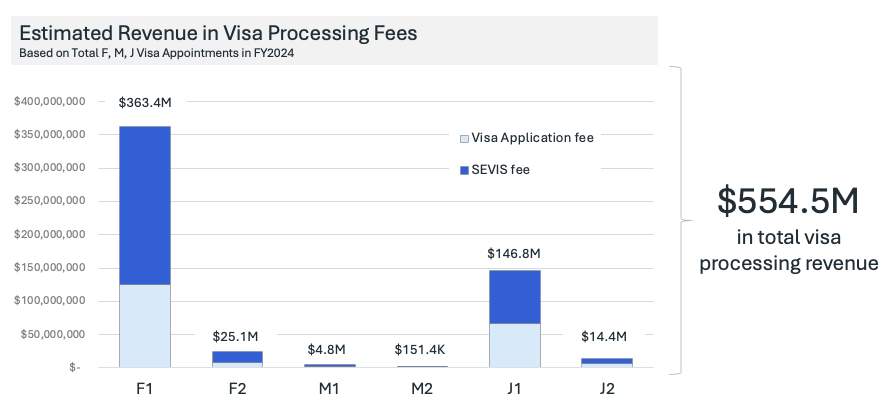With so much happening in US immigration policy, it’s critical to remind the administration and policymakers of a few key facts:
Consular Affairs is primarily funded by visa fees
International education contributes to national security
Attracting international students is an investment in America’s future
In 2024, over 1 million[1] students applied for F, M, or J visas — each paying both a visa fee and a SEVIS fee before scheduling an appointment.
Combined, student applicants contributed over $550 million in visa and SEVIS fees alone.

The State Department issued approximately 11.5 million total visas in 2024[2]. With visa fees ranging from $185-$350[3], an estimated average of $250 per visa, total visa fee revenue exceeded $2 billion, with international students making up about 28% of that revenue when SEVIS fees are included.
These fees are a major funding source for the Bureau of Consular Affairs, which can also receive appropriations to cover shortfalls — as it did during the COVID-19 pandemic with a $264 million supplemental allocation[4].
The recent visa pause at the State Department — justified as time to expand social media screening — risks significant financial loss at the most critical time of year for international student enrollment. Fall enrollment represents a majority of annual student arrivals. According to Shorelight’s analysis, 67% of student visas are issued between April and August[5] in advance of the fall semester, and these students contribute over $50 billion[6] annually to the US economy.
This pause threatens not only university revenues, but also American students, local businesses, and US global competitiveness. International students are a key part of our service export surplus, and they often return home as lifelong allies and ambassadors of American values.
In 2024, the month of June represented 40% of the fall visas. The question must be asked: Has the Department factored in the loss this financial and diplomatic shortfall will have or will it come at a cost of another crucial program?
The impact of this pause and other visa policies won’t just be felt in 2025 — it will reverberate well into 2026 and beyond.
Sources
[1] FY 2024NIVWorkloadbyVisaCategory
[2] United States: more than 11 million visas issued in 2024
[4] Congress Approves Emergency Funding to Address Coronavirus Threat
[5] Non-Immigrant Visa Monthly Statistics
[6] In Trumponomics, Banning Foreign Students Hurts Trump’s Own Economic Success Metric: Trade Deficit

